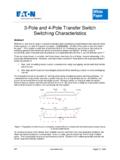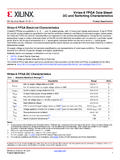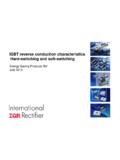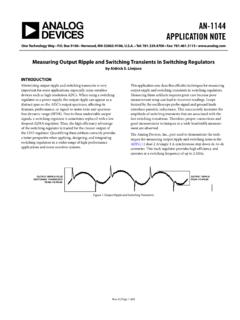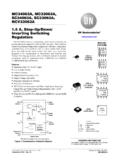Transcription of Chapter 2 Circuit and Packet Switching - Stanford …
1 Chapter2 Circuitand Packet IntroductionIt is widelyassumedthat, for reasonsof e ciency, the various communicationnet-works (Internet,telephone,TV,radio, ..) will mergeinto one ubiquitous, Packet -switched network that carriesall forms of communications. Thisview of the futureis particularlyprevalent among the Internetcommunity, whereit is assumedthatpacket-switched IP is the layer over which everythingelse will be thischapter, I present evidenceso as to arguethat this will not happen. Thisstance iscontroversial,and is di cultto make concrete,as any attemptto compare the variouscandidates for the transport infrastructure1is fraught withlack of data and the dif- culty of making apples-with-applescomparisons.
2 Therefore,the evidencepresentedhereis di erent fromother chaptersin thisthesis. Observations,casestudies, andanecdotal data(ratherthan controlled experiments, simulationsand proofs) are usedto take a stanceand to predicthow the network architecture will the initial goals of the Internet,two maincharacteristicsseemto accountfor its success:reachabilityandheterogeneity. IP, the Packet -switchingprotocol thatis the basis for the Internet,providesa simple,single,global addressto reach everyhost,enablesunfetteredaccessbetween all hostsand adapts the topology to restore1In this Chapter ,transport is used in the sense of the infrastructure over which many servicenetworksrun, not in the sense of the OSI protocol INTRODUCTION21reachability whenlinksand hidesheterogeneity in the sensethatit provides a single,simpleservice abstraction that is largely independent of thephysicallinksover which it runs.
3 As a result, IP providesservice to a huge variety ofapplicationsand operates over extremelydiverselink IP has given rise to somewidelyheldassumptionsamongstresearch ers,the networkingindustry and the publicat large. Onecommonassumption is that it is only a matterof timebefore IP becomesthe sole globalcommunicationinfrastructure, dwar ng,and eventually displacing, existing commu-nication infrastructures such as telephone, cableandTV networks. IP is alreadyuniversally used for data networkingin wirednetworks (enterprisenetworks and thepublicInternet),andis beingrapidlyadopted for data communicationsin is alsoincreasingly usedfor both local and long-distancevoice communications,and it is technically feasiblefor Packet -switched IP to related assumption is thatIP routers (basedon Packet switchingand datagramrouting)will becomethe most important, or perhapsonly, type of switchingdeviceinsidethe network.
4 Thisis basedon our collective beliefthatpacket switchingisinherently superior to circuitswitchingbecause of the e cienciesof statisticalmulti-plexingand the ability of IP to is widelyassumedthat IP issimplerthan Circuit switchingand shouldbe moreeconomical to deploy and advances in the underlying technology, we will no doubt see fasterand faster linksand routersthroughoutthe is alsowidelyassumedthat IP will becomethe commonconvergencelayer for all communicationserviceswill be builton top of IP technology. Inaddition to information retrieval, we will streamvideo and audio, place phone calls,holdvideo-conferences, teach classes,and the face of it, theseassumptions are quitereasonable.
5 Technically, IP is exibleenough to support all communication needs, frombest-e ort to real-time. Withrobust enough routersand routingprotocols,and withextensions such as weightedfair queueing,it is possible to builda Packet -switched, datagram network that cansupport any type of application, regardlessof 2. CIRCUITANDPACKETSWITCHINGIn spiteof all the strengths of IP, this chapterwill argue how it will be very hardforIP to displace will also concludehow many of the assumptionsdiscussed above are not supportedby reality, and do not stand up to of thisis to question the assumptionthat IP will bethenetwork ofthe is thatif we started over - witha cleanslate- it is notclearthat we wouldarguefor a universal, Packet -switched IP the future,more and moreusers and applicationswill demand predictability fromthe Internet,both in terms of the availability of serviceand the timely delivery of data.
6 IP wasnot optimizedto provide either,and so it seemsunlikely to displacenetworks thatalready provideboth. In this Chapter ,I take the positionthat while IP will be thenetwork layer of choice for best-e ort, non-missioncriticaland non-real-timedatacommunications(such as information exchange andretrieval), it will live alongsideother networks,such as Circuit -switched networks,that are optimized for highrev-enue time-sensitive applicationsthatdemand timelydelivery of data and guaranteedavailability of indeeda controversial position. Nevertheless, as researcherswe needto beprepared to take a stepback, to take a hardlook at the pros and consof IP, and itslikely a research and education community, we need to start thinkinghowIP will co-existand co-operate withother Organization of the providesa moredetailed description of circuitswitchingand Packet switch-ing than in Chapter1.
7 It also describes partof the earlierwork on thesetwo dissectssome of the claims about IP, especially whencom-pared to Circuit -switched networks. Thissectiontriesto demystifythoseclaimsthatdo not holdup to scrutiny. Section discussesthe implicationsfor the concludesthis BACKGROUND Background and previous workBefore starting our discussion about whetherIP can be the basisof all communicationnetworks, I will give some backgroundabout the two mainswitchingtechniquesinuse today: circuitswitchingand Packet CircuitswitchingCircuitswitchingwas the rstswitchingtechniqueused in communicationnetworksbecause it is simpleenough to carry analog signals. This thesiswill just focus on thedigital versionof course,the main exampleof its use is the phonesystem[72],but it is also used in the coreof the Internetin the form of SONET/SDHandDWDM equipment [81, 126].
8 In circuitswitching,the transmissionmediumistypically dividedinto channelsusing Frequency DivisionMultiplexing (FDM),2 TimeDivision Multiplexing(TDM)or Code DivisionMultiplexing(CDM)[172]. A circuitis a stringof concatenatedchannelsfromthe sourceto the destination that carriersan information establish the circuits,a signalingmechanism is used. Thissignaling onlycarriescontrol information, and it is consideredan overhead. It is alsothe mostcomplexpart in circuitswitching,as all decisionsare taken by the iscommonly assumedthatthe signalingand per-circuitstate management make circuitswitches hard to design, con gure and circuitswitchingthe channelbandwidthis reserved for an information ow.
9 Toensuretimelydelivery of the data, the capacity of the Circuit has to be at least equalto the peak transmission rate of the ow. In this case, the Circuit is saidto be peakallocated,and thenthe network o ersa connection-oriented service with a perfectquality of service(QoS) in termsof delay jitterand bandwidthguarantees, However,this occurs at the cost of wasting bandwidthwhen sourcesidle or simply slow occurswhenallocatingchannelsto circuitsduringcircuit/call2(Dense) WavelengthDivision Multiplexing, (D)WDM, is a subclassof FDM that uses opticalwavelengths as the sourceand the destinationneed not be be aggregationnodes in the middle of the network that combine several user ows into one big information 2.
10 CIRCUITANDPACKETSWITCHING establishment. If thereare not enough channelsfor the request, the call establishmentmay be delayed, blocked or even contrast, once the call is accepted,resourcesare not shared with other ows, eliminatingany uncertainty and, thus,removingthe needfor bu ering,processingor schedulingin the data peak allocated,the only measureof Quality of Service(QoS) in circuitswitchingis the blockingprobability of a summarize,circuitswitchingprovidestra cisolation and tra cengineering,but at the expenseof using bandwidthine ciently and signaling overhead. It is oftensaidthat these two drawbacks make circuitswitchinghighly in exible, especially ina highlydynamicenvironment such as the Internet.
